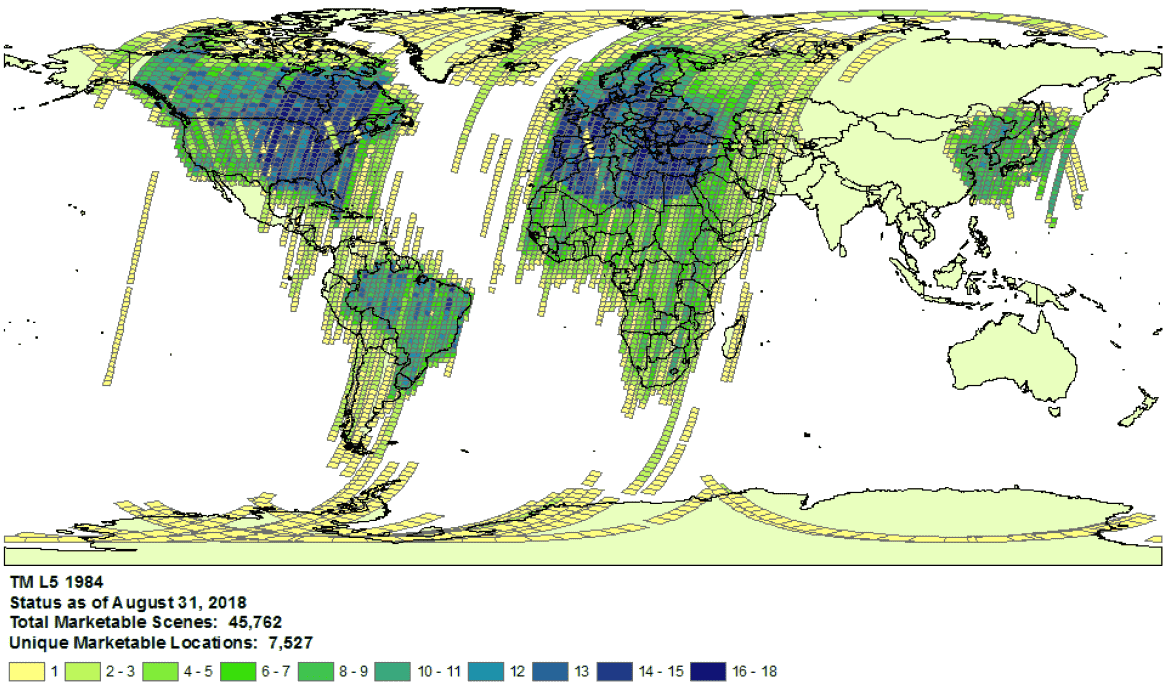Bu dokümanın amacı, Earth Engine Veri Kataloğu'nda (şu anda Landsat, Sentinel ve MODIS) bir öğenin eksik olup olmadığını belirlemenize yardımcı olmaktır.
Aşağıdaki adımlarda aşağıdakilerin nasıl yapılacağı açıklanmaktadır:
Earth Engine'ın ve sağlayıcıların kataloglarında mevcut öğeleri kontrol edin.
Eksik öğeyle ilgili onay göndermek için Earth Engine veri ekibine gerekli bilgileri toplayın.
Dikkate alınması gereken yaygın noktalar
İşleme düzeyi: Belirli bir işleme düzeyi veya ürün için tüm resimler kullanılamayabilir. Örneğin, düşük kaliteli resimler en yüksek düzeyde işlenmeyebilir.
Uzamsal ve zamansal kapsam: Her veri kümesi için düzenli bir sıklık garanti edilmez. Sensör görevi, görüntü kalitesi ve arşiv yönetimiyle ilgili farklılıklar, sağlayıcı verilerinin kullanılabilirliğini etkileyebilir.
 1984'teki Landsat 5 toplama kapsamı örneği.
1984'teki Landsat 5 toplama kapsamı örneği.
- Sağlayıcı seçimi: Veriler, veri kümesi başına seçilen bir sağlayıcıdan Earth Engine Veri Kataloğu'na aktarılır. Sağlayıcı, tam bir görev arşivi sunmuyor olabilir. Örneğin, Landsat veri kümeleri USGS arşivinden alınır. Bu arşivde, belirli alıcı istasyonlarından belirli dönemlerde görüntü eksik olduğu bilinir (daha fazla bilgi için LGAC çalışmasına bakın).
Landsat
Landsat verileri ABD Jeoloji Araştırması'ndan (USGS) alınır.
İlgilendiğiniz zaman ve alan için Landsat kapsama durumunu onaylayın.
İlgilendiğiniz zaman ve alan için tüm öğelerin listesini almak üzere Earth Engine'da arama yapın. Kodunuzda yanlışlıkla hiçbir öğenin filtrelenmediğinden emin olun. Burada bir örnek komut dosyası verilmiştir. Koleksiyonu doğru katman ve işleme düzeyiyle içe aktardığınızdan emin olun (Landsat koleksiyonu yapısı hakkında daha fazla bilgi edinin).
USGS Earth Explorer kataloğunda eksik olabilecek öğeleri arayın (Arama yapma ve veri kümesi seçme ile ilgili ayrıntılı adımlar için yardım kılavuzuna bakın). Doğru ürünleri ve işleme düzeylerini karşılaştırdığınızdan emin olun (Landsat koleksiyonu yapısına bakın). Yüzey yansıması ürünlerinin yalnızca işleme düzeyi L1TP olan Landsat görüntüleri için oluşturulduğunu unutmayın.
Sağlayıcının ürün kimliğini ve öğelerin bulunmadığını doğrulayan bir Earth Engine Code Editor komut dosyasının bağlantısını içeren bir destek kaydı göndererek eksik öğelerle ilgili ayrıntılı kanıt paylaşın.
Sentinel
Sentinel verileri Copernicus Dataspace sitesinden alınır.
İlgilenilen zaman ve alan için Sentinel kapsamının kullanılabilirliğini onaylayın (görev ayrıntılarına bakın).
Not: Sentinel-2 Level-2A ürünleri, yalnızca Mart 2018'den beri Avrupa'da yer segmentinde sistematik olarak oluşturulmaktadır ve üretim Aralık 2018'de dünya geneline genişletilmiştir (daha fazla bilgi için ESA Kullanıcı Kılavuzu'na bakın). Bunlar, 1. koleksiyonun bir parçası olarak yeniden oluşturulur.
İlgilendiğiniz zaman ve alan için tüm öğelerin listesini almak üzere Earth Engine'da arama yapın. Kodunuzda yanlışlıkla hiçbir öğenin filtrelenmediğinden emin olun. Aşağıda bir örnek komut dosyası verilmiştir. Koleksiyonu doğru işleme düzeyiyle içe aktardığınızdan emin olun.
Copernicus kataloğunda eksik olabilecek öğeleri arayın.
Sağlayıcının ürün kimliğini ve öğelerin bulunmadığını doğrulayan bir Earth Engine Code Editor komut dosyasının bağlantısını içeren bir destek kaydı göndererek eksik öğelerle ilgili ayrıntılı kanıt paylaşın.
MODIS
MODIS verileri, Land Processes Distributed Active Archive Center (LP DAAC) kaynağından alınır.
İlgilendiğiniz zaman ve alan için tüm öğelerin listesini almak üzere Earth Engine'da arama yapın. Kodunuzda yanlışlıkla hiçbir öğenin filtrelenmediğinden emin olun. Aşağıda, örnek bir komut dosyası verilmiştir. Amacınıza uygun ürünü içe aktardığınızdan emin olun.
USGS Veri Havuzu'nda Earth Engine'a eklenmemiş, eksik olabilecek öğeleri arayın. Uygun klasöre gidin ve mevcut en son dizinleri belirleyin.
"MOD" ile başlayan veri kümeleri "Terra MODIS" içindedir.
"MYD" ile başlayan veri kümeleri "Aqua MODIS"
"MCD" ile başlayan veri kümeleri "Birleştirilmiş MODIS" içindedir.
"VNP" ile başlayan veri kümeleri "S-NPP VIIRS" içindedir
Sağlayıcının ürün kimliğini ve öğelerin bulunmadığını doğrulayan bir Earth Engine Code Editor komut dosyasının bağlantısını içeren bir destek kaydı göndererek eksik öğelerle ilgili ayrıntılı kanıt paylaşın.
